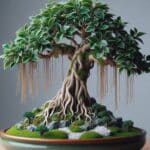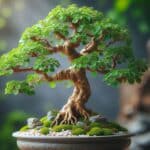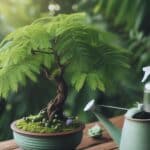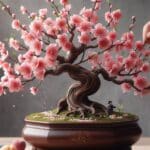All trees go through quite a few stages in their lifespan. This includes bonsai trees. For beginner hobbyists, learning more about the different life stages of each tree species is essential because this will be a huge help during their bonsai growing journey.
Bonsai trees have different needs during each growing stage, and meeting these needs is critical for keeping your tree healthy and for training and shaping it into a beautiful bonsai.
Let’s take a closer look at the different growth stages of a bonsai and their needs for each phase.
Stage 1 – Seeds or Seedlings (1 to 4 Weeks)
Bonsai trees usually start from seed or can be grown from cuttings acquired from mature trees. Growing a bonsai tree from seed can take a very long time. Growing bonsai trees from cuttings can be quicker since the cutting will produce a much thicker trunk to work with much quicker. Let’s take a peek at these two main bonsai starter methods.
Growing Bonsai from Seed (1 – 3 Weeks)
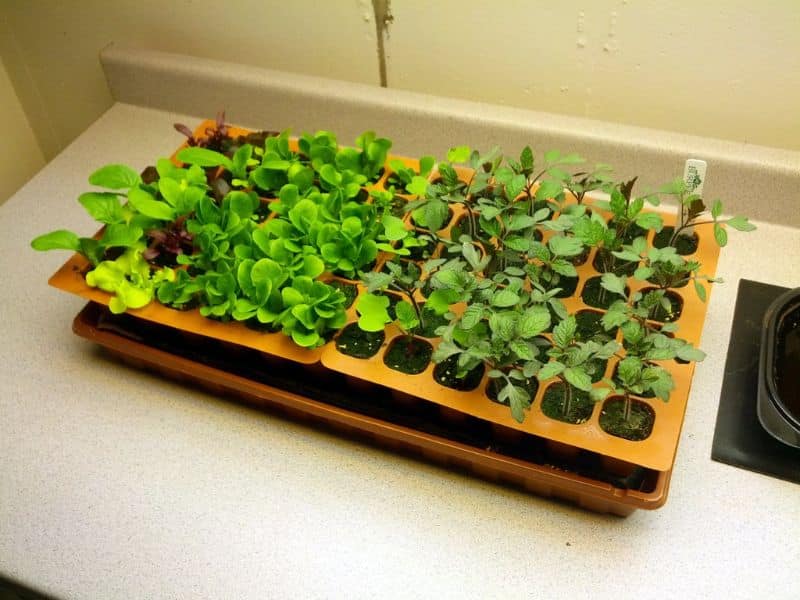
You can find bonsai seeds inside fruits, harvest them from your local surroundings, or buy quality seeds online.
It can be a bit tricky to grow some tree species from bonsai seed. You will need to recreate a suitable environment to get the seeds to germinate. This might be as simple as placing the seeds inside a moist paper towel in a plastic bag. It can be a complex process that requires stratification (a cold period), seed scarification, and laboratory conditions, or the seed might not sprout.
Different tree species have different germination needs, and you will need to research what the seeds require to start growing.
When the seed germinates and develops roots and leaves, it will be known as a seedling.
Seedlings can be started by soaking them in water and keeping them in a moist paper towel until they germinate or planted directly in the soil.
Nurseries typically start their seedlings in a growing tray or seedling tray and then transplant the seedling in a small container once it grows.
Growing Bonsai from Cuttings (3 – 4 Weeks)

It is often a lot easier to grow a bonsai from cuttings, but not all species have a high success rate with this growing method.
To grow a bonsai tree from a cutting, you usually need to take 6-inch cuttings and dip the end in rooting hormone before planting it in a container with moist soil. After a few weeks, the cutting should develop a root system and sprout new leaves and branches.
A seedling or bonsai grown from a cutting is usually planted in a small 4-inch container. Commercial nurseries usually plant these seedlings in a soil mix that consists primarily of fir bark. Fir bark is an excellent growing medium for a seedling since it retains water well to keep the delicate roots moist and offers many nutrients.
Stage 2 – Sapling – (One Year)
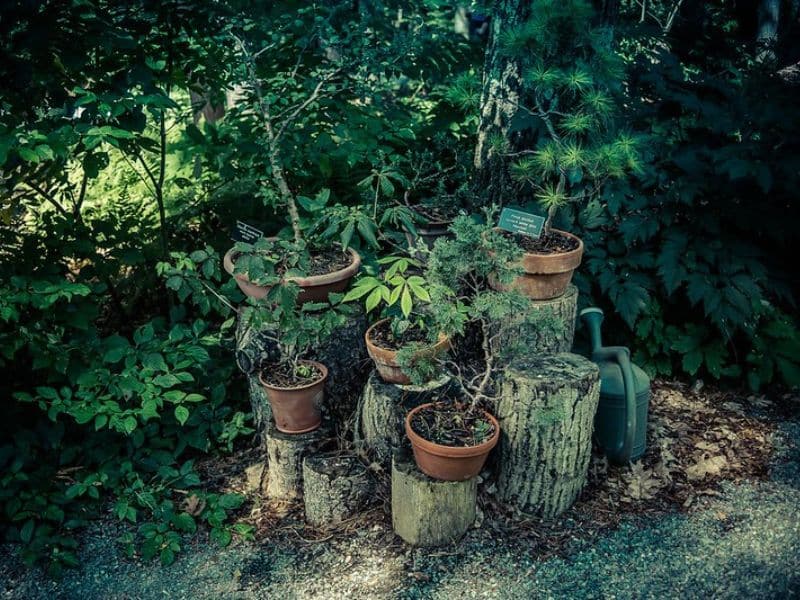
When a seedling reaches about 4 inches tall, it is usually considered a sapling. Saplings are usually transplanted into a larger 1-gallon container so there will be more room for the root system to develop.
Bonsai artists who want to grow a small tree, especially Kumono or Chohin bonsai, might keep the seedling inside the small container since this will stunt its growth.
Growing a bonsai sapling in a larger container can, however, be beneficial if you want your tree to produce a thicker trunk or if you want to encourage healthier root growth so you can create bonsai trees with exposed root systems.
It is usually best to let a sapling grow naturally for at least a year. The tree should be kept outdoors in normal potting soil where it will get enough sunlight. This will encourage lots of healthy growth and help the tree develop a strong root system.
Stage 3 – Early Bonsai Development (1-5 Years)
Nurseries usually transplant sapling trees into 5-gallon containers when they become large and show vigorous growth. During this phase, the tree will develop from a sapling into a young tree.
Most bonsai enthusiasts like to start their bonsai journey with a young tree because this is usually when the tree is strong enough to handle invasive techniques.
You can easily acquire a healthy young tree from a local nursery. Nursery stock trees are relatively affordable and are usually just right to start pruning and training.
During this stage, your bonsai tree will undergo several transformations, like the following.
Repotting Into a Bonsai Container
The bonsai will need to be repotted for the first time. Planting it in a suitable bonsai pot with a flattened design is usually best. This will help domesticate the rootball and root mass of the little tree so it can grow better despite its limited space.
Bonsai trees need to be planted in proper containers with lots of drainage holes so they will develop root rot. It should also be transferred from normal potting soil and planted in a bonsai mixture.
When the plant is repotted, the roots are usually pruned. About one-third of the root system needs to be removed, and the tree should be kept in a warm shaded position until the rootball can be restored.
Choose a Specific Bonsai Shape
This is when you will need to study the natural shape of your tree. Do some research on common bonsai tree shapes and choose a style that will work well with your tree’s natural shape and design.
Selecting a suitable bonsai shape will make it much easier to prune and structure your tree and help it grow in the right direction.
Start On Wiring and Pruning Techniques
A bonsai’s trunk and branches can only be manipulated when soft and flexible. If you wait too long, modifying the tree into a particular shape will be difficult.
Wiring and pruning bonsai are two techniques that are commonly used when shaping a tree. Unwanted branches must be pruned away, and ingrown foliage or branches can be removed.
The remaining branches can then be wrapped in aluminum or copper wire so they can be bent into a desired shape.
Define the Trunkline From the Base to the Tip of the Tree
The tree’s trunk needs to be trained before it becomes too thick or hard. The main goal right now will be to develop a taper. This means the trunk should be thicker at the roots and thinner towards the top.
Young trees are easy to taper since they are naturally thicker at the base. It is also straightforward to manipulate the shape of a young tree since the soft trunk can easily be wrapped in wire and bent into a different shape.
Many bonsai artists do, however, like to start with an older tree since the trunk is already pretty thick. If you are using an older tree, you must chop it shorter to encourage branching. The older trunk portion must be carefully shaped to create a smooth tapered design. This can be challenging since it can be difficult to conceal a large scar.
Grow the Trunk Thicker
Even though your tree is now positioned in a smaller container, you must do what you can to let it grow and develop. Growth is important for thickening the trunk and can help the tree store more energy for winter.
The thicker the tree’s trunk grows, the more mature the tree will appear.
Develop Some Interesting Primary Branches
When pruning the tree for the first time, you must select branches you will keep. These are called primary branches. The primary branches can be cleaned up by pinching off some internal growth. They are also wrapped in wire so they can be manipulated and grown in a certain direction.
Heal and Conceal Large Wounds Created by Pruning Techniques
Pruning can leave behind a lot of scars. Some tree species are also much more likely to develop deep and unattractive scarring compared to other species.
As your tree grows, you will need to carefully work on the scars left over by invasive techniques like pruning or shaping. The main idea is for the tree to appear as natural as possible. Visible scarring like chopped-off branches will give the tree an unnatural appearance.
Positioning
After repotting and pruning the tree, you will need to keep it in a more suitable environment. The perfect spot for your bonsai depends on the species. Indoor bonsai species can easily become scorched if kept outdoors or die of frost during chilly winters. On the other hand, outdoor bonsai probably won’t grow well if you keep it indoors since it needs more direct sunlight.
A deciduous bonsai tree might also rely on a cold dormancy stage for survival. If it doesn’t undergo a dormancy stage, the tree won’t have enough time to rest and it can become weak.
Even though you might start on some shaping and pruning techniques, you should allow the tree to grow naturally. Allow lots of natural foliage growth and top off long shoots to encourage branching.
Stage 4 – Secondary Structure Development (5-10 Years)

Once the bonsai has settled into a bonsai pot and sports lots of healthy root growth and a basic structure, you can get to work on the secondary structure.
This stage involves quite a few steps like the following.
Cultivate a Domesticated Root Mass
Bonsai trees are usually repotted every 2 – 5 years to keep the tree small so it will have all the needed nutrients. While you are repotting the tree, you should be careful to inspect the root ball. About one-third of the tree’s root system is usually removed during repotting. The remaining roots are carefully positioned so they can develop into healthier patterns that will help stabilize the tree better.
The amount of fertilizer the tree gets tends to reduce during this stage because the tree already has a pretty defined shape and you don’t want excessive growth to ruin the style of your tree.
Grow and Shape Secondary Branches
If you want your bonsai to seem aged and miniaturized then it should have lots of secondary branches. Secondary branches can add lots of visual interest to your little tree since most of the foliage will develop on these thinner branches.
A variety of techniques can be used to develop beautiful branches and to keep these branches relatively short.
The terminal growth tip of the branches is usually removed to encourage more interior shoots. These interior shoots can give the tree a fuller appearance.
Some artists also use the hormone auxin on the tips of the branches. This hormone suppresses growth in these branches so they won’t become too long or vigorous.
The secondary branches can also be wired to define their shape.
Thicken Branches and Stem
The branches will naturally thicken as the tree ages. Stems will also become thicker if they are cropped short and if they have lots of offshoots.
Heal and Conceal Wounds
Pay attention to the old and new pruning wounds on the tree. There are quite a few different techniques you can try to conceal wounds that are too apparent. For example, some artists like to remove a portion of the bark around a large scar. This adds more texture and interest to the tree.
Stage 5 – Refinement Stage (+10 Years)
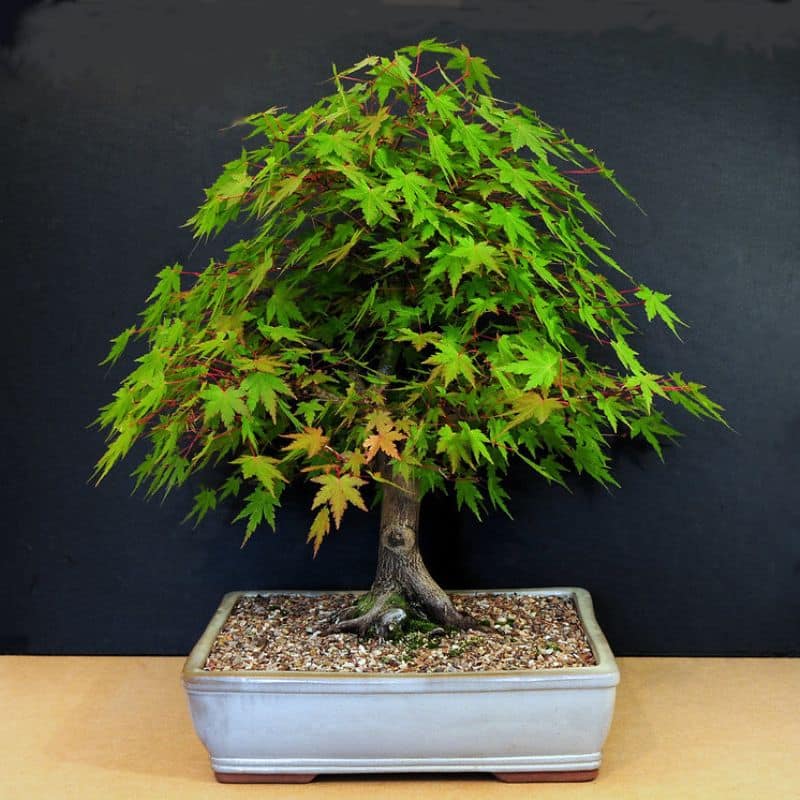
During the refinement stage, the amount of maintenance of your tree will be greatly reduced. At this point, your tree should already be quite mature. Most bonsai trees are 10 years and older at this point in their growth but for slow-growing bonsai, it can take up to 21 years to achieve this stage.
Here is a quick look at what bonsai craftsmen focus on while caring for an established bonsai.
Maintain a Healthy Rootball
Mature trees are repotted every 3 – 5 years. Drought-tolerant species can be repotted even more infrequently. Coniferous bonsai can also be kept in the same container for up to 8 years before repotting is required.
When the tree is repotted, the roots are pruned and it is planted in some fresh potting soil. The main goal is to force the tree to form a ramified network of roots. To achieve this, the bonsai isn’t repotted quite as often as it used to be.
It is best to only repot the bonsai tree if the pot is completely full of roots with little room for soil or when the soil has become too worn out to support the tree.
Balance Foliage Growth Across the Tree
The foliage on the network of secondary branches and offshoots is carefully maintained to give the tree a balanced appearance. A variety of techniques can be used to create balanced foliage development all over your tree.
Growers usually pinch back overly large leaves or remove ingrowth. Defoliation can also be done on deciduous trees and some evergreens to encourage the tree to grow smaller leaves.
Maintain the Style and Shape of the Bonsai
When the tree has a defined and balanced shape, you will still need to do some light pruning to keep it in good shape throughout the years. This is especially true for fast-growing trees that might quickly outgrow the specific bonsai style you might be trying to develop.
Most bonsai trees are pruned during early spring before the growing season begins. This form of seasonal pruning will encourage lots of healthy new growth for the tree so it will look young and fresh.
Once the foliage recovers, bonsai artists also do a little bit of light but regular pruning throughout the growing season. This usually involves pinching off ingrown shoots, shortening overly long shoots, removing overly large foliage, and clearing away spent flowers.



